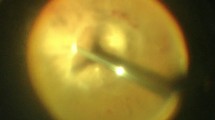Abstract
Purpose
To evaluate the duration of room air tamponade and its associated factors.
Study design
Retrospective cohort study
Methods
The present study reviewed the medical records of patients who received room air tamponade after vitrectomy between Jun 2015 and Dec 2016. The room air duration was assessed by patient interviews 2 weeks after surgery. Relationships between the variables and tamponade duration were determined using logistic regression analysis. The remaining air level was determined from medical records.
Results
The room air tamponade had dissipated by 11.1 ± 1.3 days after surgery. The duration was 11.2 ± 1.3 days for eyes with a spared posterior capsule, longer than the duration in other eyes (10.1 ± 0.9 days). Increased axial length was correlated with increased duration. Axial length and a spared posterior capsule were significantly correlated with tamponade duration. Its half-life was presumed about 3.3 days. The room air seems to be absorbed at a constant rate.
Conclusion
The data suggest that room air tamponade remains in the vitreous cavity for an average of 11.1 days. Axial length and posterior capsule status were associated with duration.





Similar content being viewed by others
References
Schaal KB, Bartz-Schmidt KU, Dithmar S. Current strategies for macular hole surgery in Germany, Austria and Switzerland. Ophthalmologe. 2006;103:922–6 (in German).
Tan HS, Oberstein SY, Mura M, Bijl HM. Air versus gas tamponade in retinal detachment surgery. Br J Ophthalmol. 2013;97:80–2.
Lee SJ, Kwon HJ, Park KY, Park SW, Byon IS, Lee JE. Prognostic factors of anatomical success in microincisional vitrectomy for rhegmatogenous retinal detachment. J Korean Ophthalmol Soc. 2016;57:1613–8.
Pak KY, Lee SJ, Kwon HJ, Park SW, Byon IS, Lee JE. exclusive use of air as gas tamponade in rhegmatogenous retinal detachment. J Ophthalmol. 2017;2017:1341948.
Zhou C, Qiu Q, Zheng Z. Air versus gas tamponade in rhegmatogenous retinal detachment with inferior breaks after 23-gauge pars plana vitrectomy: a prospective. Randomized Comparative Interventional Study. Retina. 2015;35:886–91.
Martinez-Castillo V, Boixadera A, Verdugo A, Garcia-Arumi J. Pars plana vitrectomy alone for the management of inferior breaks in pseudophakic retinal detachment without facedown position. Ophthalmology. 2005;112:1222–6.
Martinez-Castillo V, Verdugo A, Boixadera A, Garcia-Arumi J, Corcostegui B. Management of inferior breaks in pseudophakic rhegmatogenous retinal detachment with pars plana vitrectomy and air. Arch Ophthalmol. 2005;123:1078–81.
Tripathy K. Re: Martinez-Castillo et al.: Pars plana vitrectomy alone for the management of pseudophakic rhegmatogenous retinal detachment with only inferior breaks (Ophthalmology. 2016;123:1563–1569). Ophthalmology. 2017;124:e52.
Iezzi R, Kapoor KG. No face-down positioning and broad internal limiting membrane peeling in the surgical repair of idiopathic macular holes. Ophthalmology. 2013;120:1998–2003.
Eckardt C, Eckert T, Eckardt U, Porkert U, Gesser C. Macular hole surgery with air tamponade and optical coherence tomography-based duration of face-down positioning. Retina. 2008;28:1087–96.
Tsai W-T. The decomposition products of sulfur hexafluoride (SF 6): reviews of environmental and health risk analysis. J Fluor Chem. 2007;128:1345–52.
Thompson JT. Kinetics of intraocular gases. Disappearance of air, sulfur hexafluoride, and perfluoropropane after pars plana vitrectomy. Arch Ophthalmol. 1989;107:687–91.
Wong RF, Thompson JT. Prediction of the kinetics of disappearance of sulfur hexafluoride and perfluoropropane intraocular gas bubbles. Ophthalmology. 1988;95:609–13.
Parver LM, Lincoff H. Geometry of intraocular gas used in retinal surgery. Mod Probl Ophthalmol. 1977;18:338–43.
Parver LM, Lincoff H. Mechanics of intraocular gas. Invest Ophthalmol Vis Sci. 1978;17:77–9.
Mohamed S, Lai TY. Intraocular gas in vitreoretinal surgery. Hong Kong J Ophthalmol. 2010;14:8–13.
Oj K, Tg L, Sj N. Primary 23 gauge transconjunctival sutureless vitrectomy with air tamponade for simple rhegmatogenous retinal detachment. J Korean Ophthalmol Soc. 2011;52:190–6.
Lincoff H, Maisel JM, Lincoff A. Intravitreal disappearance rates of four perfluorocarbon gases. Arch Ophthalmol. 1984;102:928–9.
Abrams GW, Edelhauser HF, Aaberg TM, Hamilton LH. Dynamics of intravitreal sulfur hexafluoride gas. Invest Ophthalmol. 1974;13:863–8.
Yoon YH, Marmor MF. Rapid enhancement of retinal adhesion by laser photocoagulation. Ophthalmology. 1988;95:1385–8.
Folk JC, Sneed SR, Folberg R, Coonan P, Pulido JS. Early retinal adhesion from laser photocoagulation. Ophthalmology. 1989;96:1523–5.
Masuyama K, Yamakiri K, Arimura N, Sonoda Y, Doi N, Sakamoto T. Posturing time after macular hole surgery modified by optical coherence tomography images: a pilot study. Am J Ophthalmol. 2009;147(481-8):e2.
Author information
Authors and Affiliations
Corresponding author
Ethics declarations
Conflicts of interest
J. J. Lee, None; H. J. Kwon, None; S. M. Lee, None; I. S. Byon, None; J. E. Lee, None; S. W. Park, None.
Additional information
Publisher's Note
Springer Nature remains neutral with regard to jurisdictional claims in published maps and institutional affiliations.
Corresponding author: Sung Who Park
About this article
Cite this article
Lee, J.J., Kwon, H.J., Lee, S.M. et al. Duration of room air tamponade after vitrectomy. Jpn J Ophthalmol 64, 216–222 (2020). https://doi.org/10.1007/s10384-020-00714-7
Received:
Accepted:
Published:
Issue Date:
DOI: https://doi.org/10.1007/s10384-020-00714-7




